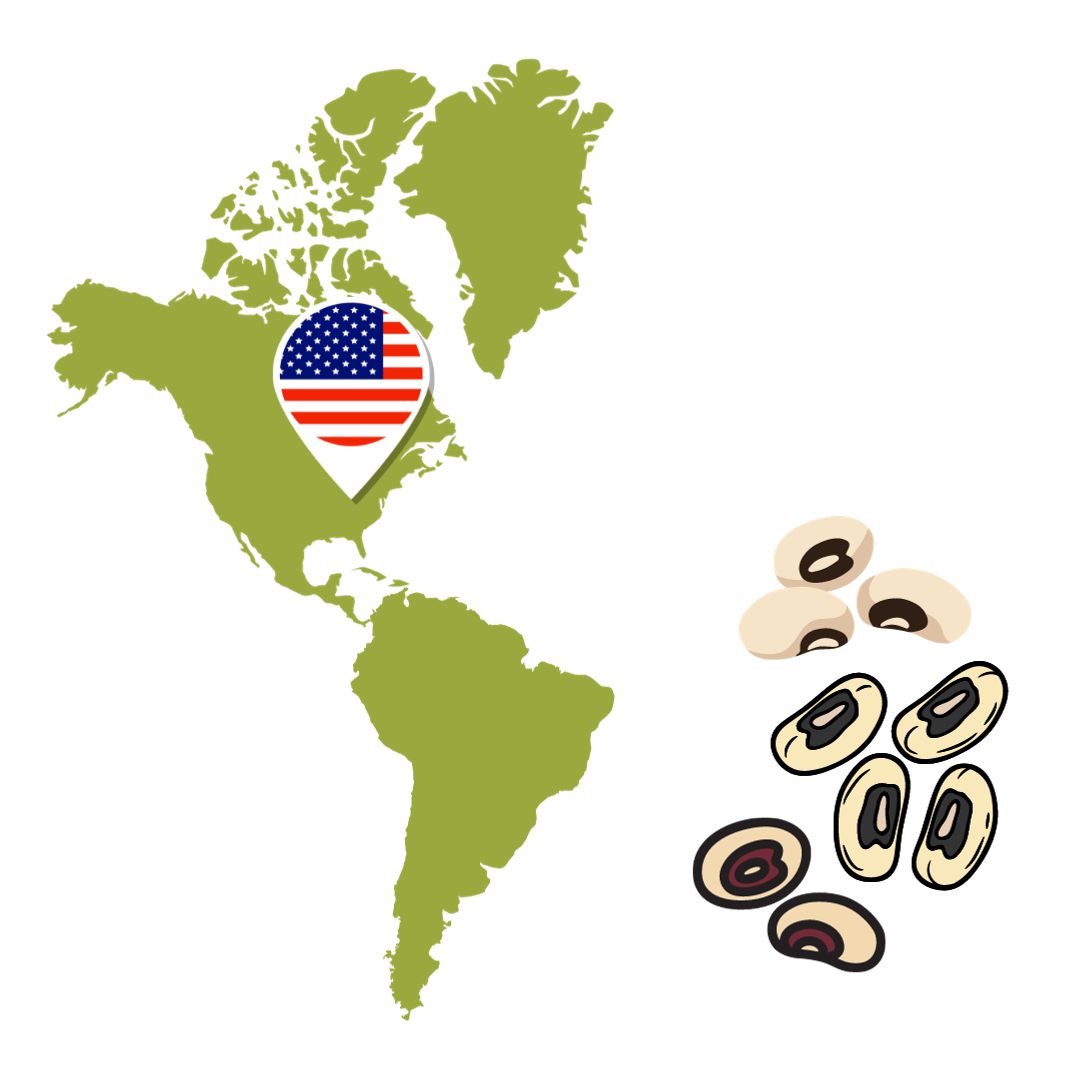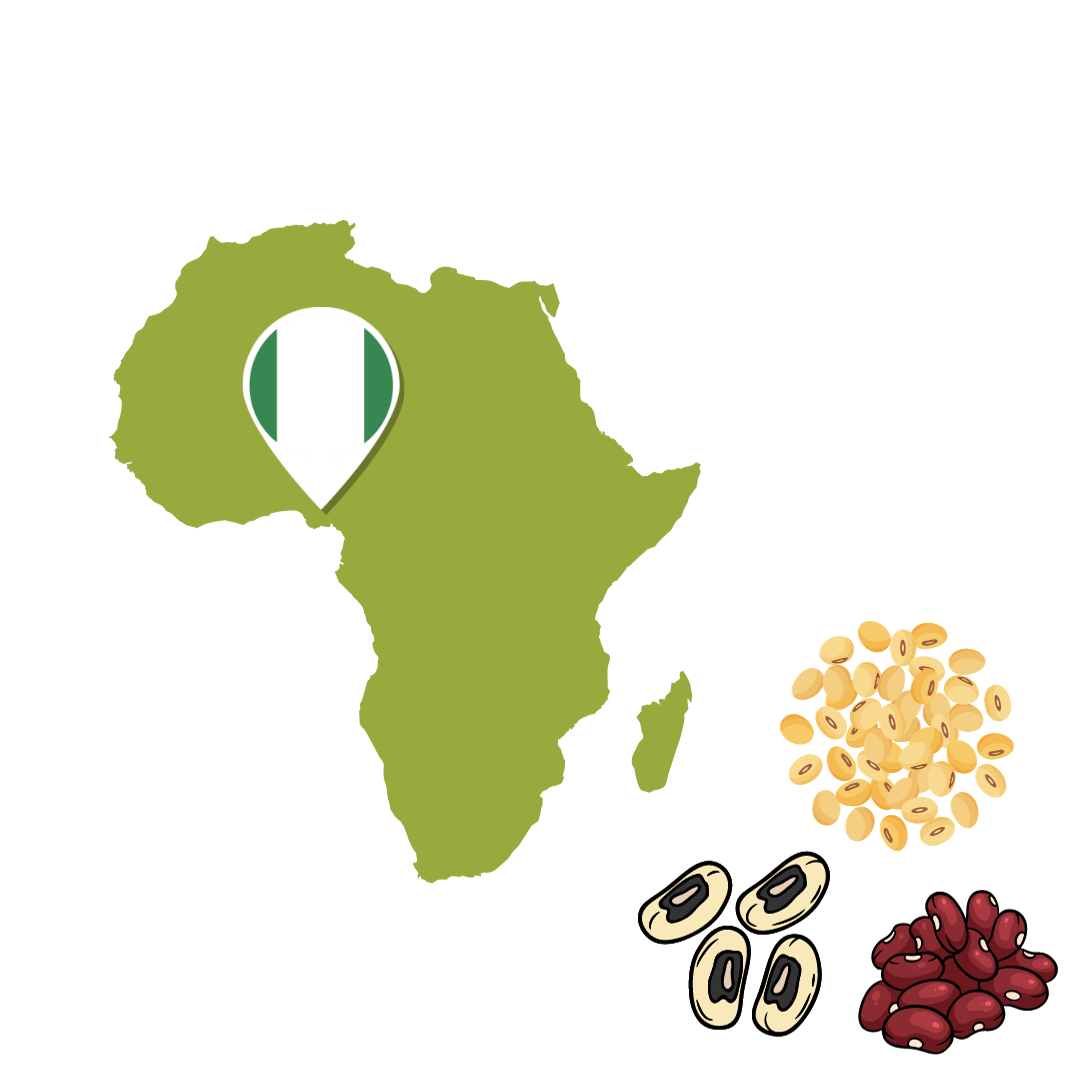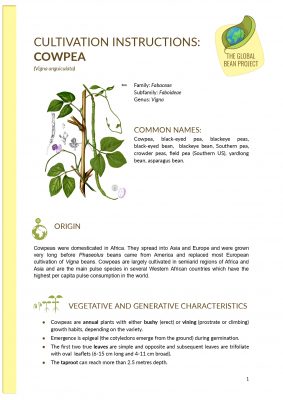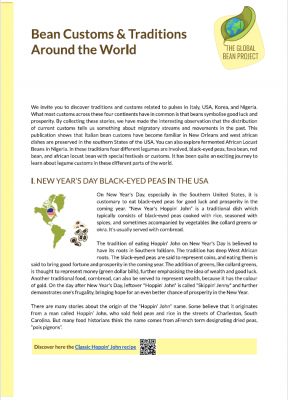We invite you to discover traditions and customs related to pulses in Italy, USA, Korea, and Nigeria. What most customs across these four continents have in common is that beans symbolise good luck and prosperity. By collecting these stories, we have made the interesting observation that the distribution of current customs tells us something about migratory streams and movements in the past. This publication shows that Italian bean customs have become familiar in New Orleans and west african dishes are preserved in the southern States of the USA. You can also explore fermented African Locust Beans in Nigeria. In these traditions four different legumes are involved, black-eyed peas, fava bean, red bean, and african locust bean with special festivals or customs. It has been quite an exciting journey to learn about legume customs in these different parts of the world.
I. NEW YEAR’S DAY BLACK-EYED PEAS IN THE USA

On New Year’s Day, especially in the Southern United States, it is customary to eat black-eyed peas for good luck and prosperity in the coming year. “New Year’s Hoppin’ John” is a traditional dish which typically consists of black-eyed peas cooked with rice, seasoned with spices, and sometimes accompanied by vegetables like collard greens or okra. It’s usually served with cornbread.
The tradition of eating Hoppin’ John on New Year’s Day is believed to have its roots in Southern folklore. The tradition has deep West African roots. The black-eyed peas are said to represent coins, and eating them is said to bring good fortune and prosperity in the coming year. The addition of greens, like collard greens, is thought to represent money (green dollar bills), further emphasising the idea of wealth and good luck. Another traditional food, cornbread, can also be served to represent wealth, because it has the colour of gold. On the day after New Year’s Day, leftover “Hoppin’ John” is called “Skippin’ Jenny” and further demonstrates one’s frugality, bringing hope for an even better chance of prosperity in the New Year.
There are many stories about the origin of the “Hoppin’ John” name. Some believe that it originates from a man called Hoppin’ John, who sold field peas and rice in the streets of Charleston, South Carolina. But many food historians think the name comes from aFrench term designating dried peas, “pois pigeons”.
| Discover here the Classic Hoppin’ John recipe |
II. LEGUMES DURING ST. JOSEPH’S DAY NEW YEAR AND CHRISTMAS SEASON IN ITALY
Fava beans during St. Joseph’s Day
In some regions of Italy, especially in Sicily, St. Joseph’s Day, on March 19th, is celebrated with a special dish known as “Frittella di San Giuseppe,” which includes fava beans. Fava beans are considered to be a symbol of luck and protection. Fava beans are also widely used in Apulian cuisine and are a key ingredient in dishes like “Fave e Cicoria” (fava beans and chicory). Saint Joseph or San Giuseppe is celebrated by giving food to the needy in remembrance of the legend that says Saint Joseph interceded to end a famine in Sicily during the Middle Ages. The famine ended with rain and then a rich harvest of fava beans.
Today people still celebrate this day by setting up tables in Catholic churches, the so-called St. Joseph Tables (Tavole di San Giuseppe) and sharing a soup made with fava beans and Neapolitan pastry, known as Zeppole di San Giuseppe. Because March 19 falls in the Lent period, no meat is allowed to be eaten. Therefore, fava beans served as a good nutritional alternative. It is said that fava beans grow during drought periods when nothing else would. So when anyone leaves the celebration — besides carrying a bag of leftovers — they take along at least one “lucky fava bean” for the next year.
This bean custom carried its influence with the arrival of Italian immigrants – 290,000 according to the City of New Orleans records- settling in what had been the French Quarter during a 40-year period commencing in 1884. The area became known as “Little Palermo.” The recipe underwent some changes and adapted to local ingredients. On St. Joseph’s Day in New Orleans, fig cookies (cucidati) and honey ball cookies (pignolata) are found on the St. Joseph altars in addition to fava beans.
| Discover here the Fava Beans Soup recipe |
Eating lentils on New Year’s Eve
Lentils are believed to bring good luck in the coming year and are a staple in New Year’s Eve dishes. Lentils are a symbol of “growing prosperity” because they increase in volume when cooked. The tradition dates back to ancient Rome, when people would give a purse full of lentils as a gift to wish luck and wealth in the new year. The typical dish is lentil stew with “cotechino” or “zampone”, which are types of pork sausage that represent abundance, fertility and strength. The stew is usually served shortly after midnight, along with sparkling wine such as Prosecco or Spumante.
Chickpeas (Ceci) & beans (“fagioli”) on Christmas Season
Chickpeas are used in various Apulian dishes, including “ciceri e tria,” a traditional pasta dish. Chickpeas are also used in the preparation of “pure di ceci”, a spread or dip made from chickpeas, often consumed during the Christmas season. Besides, “fagioli all’uccelletto” (beans in tomato sauce) and “fagioli con le cotiche” (beans with pork rind) are often served during the Christmas season. The most common beans (fagioli) are cannellini and borlotti beans. They are found almost everywhere and most versions of traditional pasta fagioli feature one or both of these beans.
III. WINTER SOLSTICE AND THANKSGIVING IN SOUTH KOREA
Patjuk during winter solstice
In Korea, people customarily enjoy red bean porridge (Patjuk) with rice balls on Dongji, on December 22nd, which is the winter solstice and is the longest night of the year. Traditionally, Patjuk was prepared to prevent bad luck and to be shared with neighbours. Korean people usually eat Dongji Patjuk with Saealsim, which looks like a small bird’s egg and is made of sticky rice. People believe that Yin energy reached its peak in Dongji. Thanks to the red colour, in traditional belief systems red beans symbolised Yang energy, which was thought to have the power to expel evil Yin spirits. Therefore, people believed that they would be able to ward off evil spirits by eating red bean porridge on Dongji. The round bird’s egg symbolises the sun, and it is a ceremony to hold the energy of life together. It means to defeat the darkness and wish for a quick physical recovery. Dongji also traditionally marks the actual beginning of New Year. It is traditionally said that you have to eat one rice ball for each year of your age.
We can see a similarity between the Winter solstice (Dongji) in Korea and Halloween in the Western culture. Halloween originated from the sentence “All Hallows’ Eve” and is celebrated in the evening before All Saints’ Day, or All Hallow’s Day, on November 1st. Halloween is a holiday that creates a bizarre and gloomy atmosphere so that the ghosts of the dead are driven away and do not interfere with All Saints’ Day.
Songpyeon (rice cake filled with various beans) for Thanksgiving day
Chuseok, also known as Korean Thanksgiving day, stands as one of South Korea’s most important and widely celebrated holidays, occurring on the 15th day of the 8th month in the lunar calendar. It is a time for Koreans to express their gratitude for the year’s harvest, to strengthen family and community bonds, and to pay respects to their ancestors through the “Charye” ritual. This celebration involves the preparation of traditional foods, such as rice cakes (Songpyeon) and pancakes made with beans.
Songpyeon on the Chuseok holiday
During the Chuseok (Hangawi) holiday, Korean families come together, sit around and make Songpyeon, a half-moon shaped rice cake made from freshly harvested rice. These are commonly filled with sweet red beans, black beans, roasted sesame seeds and chestnuts. The history of Songpyeon’s unique half-moon shape dates back to before the Unified Silla Period. Originally named Songbyeong, combining “Pine Tree” and “Tteok” (rice cake), it was later simplified to Songpyeon. This shape contrasts with China’s full moon-shaped mooncakes. The transformation to a half-moon shape is linked to a Baekje legend. During King Uija’s reign (642-660), the last king of Baekje, a turtle emerged from the palace ground with a carving on its back: “Baekje is full moon, and Silla is half moon.” Seeking an interpretation, the king consulted a fortune teller, who explained that as the full moon wanes, the half moon fills up, signifying the shifting fortunes toward Silla. This story spread, leading Unified Silla to adopt the half-moon shape, symbolising hope for a better future. Notably, Songpyeon’s original round shape transforms into a half moon as it’s filled and folded, depicting the changing phases of the moon and encompassing both the full and half moon shapes.
| Discover here the Songpyeon Recipe and the Patjuk Recipe |
IV. YORUBA CULTURE IN NIGERIA

The Yoruba people, one of the largest ethnic groups in West Africa, are primarily concentrated in southwestern Nigeria. Yoruba culture has a rich and diverse tradition, and beans play a significant role in their customs and traditions in various ways.
The Yoruba culture in Nigeria is highlighted by the Osun Osogbo festival, which celebrates the Yoruba goddess Osun and promotes Yoruba unity through spirituality, art, and community involvement. The festival features a sacred grove, a grand procession, and a rich display of Yoruba arts and crafts. African Locust beans, known as “Iru” in Yoruba, play a crucial role in the festival. They symbolise fertility and are used in Yoruba cuisine, enriching the festival’s culinary traditions. Iru, a fermented locust bean, is a popular seasoning in traditional soups and stews, and has remarkable health benefits. It is processed through boiling, dehulling, and fermentation, and is used in various Nigerian dishes, including Locust Bean Stew (Obe Oniru).
In Yoruba marriage and engagement ceremonies, certain varieties of beans hold a culturally significant role. They are traditionally incorporated into the dowry or served as dishes to guests. These beans symbolise and represent the expectation of a prosperous and fertile marriage.
- Black-Eyed Peas (Cowpeas): Black-eyed peas are a popular choice in Yoruba culture for various rituals and ceremonies, including weddings and engagements. They are often seen as a symbol of fertility and prosperity, making them a meaningful addition to the dowry.
- Soybeans: Soybeans may also be used as they are associated with nourishment and sustenance, which are important aspects of a successful and prosperous marriage.
- Brown Beans: Brown beans are another type often chosen for their significance as a source of nourishment and well-being.
There are various celebratory Bean dishes prepared at the occasion of Yoruba engagements and weddings. The choice of the bean-based dish served to guests can vary depending on regional customs, personal preferences, and the nature of the event. Some examples are:
- Moimoi, a popular nutritious Nigerian bean pudding or bean cake made from black-eyed peas or brown beans, frequently served at Yoruba celebrations.
- Akara, deep-fried bean cakes served as a snack and appetizer at events.
- Ewa Agoyin, mashed brown beans, staple in Yoruba cuisine and commonly served at celebrations.
| Discover here the Locust Beans Stew Recipe |




